All our fantasy baseball rankings for 2023 can be found inside our Draft Kit. Sign up to PL Pro to access all our 2023 player projections with our auction draft calculator.
Before we get started, I’ll briefly review my basic assumptions and philosophy:
These rankings assume a 5×5 head-to-head categories format with one catcher, one first baseman, one second baseman, one shortstop, one third baseman, three outfielders, two utility hitters, a shallow bench, and at least two IL spots. I am also assigning eligibility based on five starts at the position, so don’t be entirely shocked if your host site doesn’t list some of these guys at each position I list below. The scoring categories for hitters that I’m basing these rankings on are runs scored, home runs, runs batted in, stolen bases, and batting average.
Unlike deeper formats with an overall component like the NFBC, standard head-to-head leagues don’t put much of a premium on stolen bases. Additionally, the relatively high replacement level at most positions suppresses the value of players with high floors but low ceilings (like Jean Segura), so as we get to the later part of the rankings you’ll see that I value upside quite a bit more than safety.
There are leagues of all shapes and sizes out there, and I can’t possibly accommodate all of them in a single set of rankings. Don’t hesitate to reach out in the comments if you want to know whether a setting or situation would dramatically change a ranking, but in general, players won’t slide up or down more than one or two tiers (most will move even less) unless it’s an extreme or highly unusual scenario.
With that out of the way, let’s dive into the rankings!
Please note that these are actually DH rankings and NOT Utility rankings. Players needed five starts at DH to qualify.
Tier 1
1. José Ramírez (CLE), 3B/DH
Ramírez is a five-category contributor with an elite floor and an elite ceiling, and my top overall player.
Ramírez heads into 2023 as the king of the hot corner after finishing as fantasy’s best third baseman for the fourth time in five seasons (2018, 2020, 2021, and 2022). For what it’s worth, he also finished as the second-best third baseman in 2017. Not only has Ramírez been the top third baseman, but he has also finished as a top-five hitter overall in those four seasons as well. No other player in baseball can make the same claim (Trea Turner has been in the top five three times in that span, and Freddie Freeman has been there twice).
Due to the real depth drop-off at third, there are several good reasons to consider J-Ram as the top overall pick in your fantasy draft. If you choose to pass on Ramírez, there’s a very real chance that you will miss out on almost the entire next tier, and all of a sudden you’re going to be feeling the squeeze at third base after you’ve made just a single pick.
As long as J-Ram plays a full season—something he’s done in seven of the last eight years with his lowest games played total sitting at 129—he’s possibly the best bet in the game to finish as a top-10 overall player and a top-five hitter.
2. Aaron Judge (NYY), OF/DH
There’s an unwritten rule in fantasy rankings — when you break the AL home run record, you automatically get to be first at your position the following season. The main reason it’s unwritten is that the AL home run record is considerably older than fantasy so it’s never actually come up.
There really isn’t much to say about Judge. While he was once an injury risk, two consecutive healthy seasons are enough for me to no longer have any major concerns about his durability, and his 16 stolen bases were icing on the Aaron Judge cake. That number might be a little tough for him to repeat, but I think at least 10 should be in order with the rule changes coming that will make it easier for runners to steal second.
100 runs, 100 RBI, and 40 home runs almost feel like a floor, and in leagues where you don’t care about stolen bases, there’s a good argument for taking Judge as the top overall player. I’m partial to José Ramírez in the top spot, but I wouldn’t begrudge you for taking fantasy’s best power source.
3. Yordan Alvarez (HOU), OF/DH
I loved seeing Yordan put in a second straight mostly-full season after missing a ton of time due to knee injuries. I had some concerns about whether Alvarez could consistently drive the ball on a pair of bum knees, but 70 combined home runs over the last two seasons are more than enough evidence that he’s feeling just fine. I also loved that Alvarez regained the elite plate skills he showed in his rookie season, walking in 13.9% of his plate appearances while striking out in just 18.9% of them. Those ratios give him an incredible floor with respect to ratios, as evidenced by the .306/.406/.613 line Alvarez delivered in 2022.
His complete and total lack of speed isn’t something that a rule change can fix, and it’s the only reason Alvarez is at the bottom of this tier. Points league and OBP league managers might consider bumping him up a bit if stolen bases aren’t a big impact in your format, though the top of this position is so strong that it’s hard to move just about anyone up inside the top 10 to 15 outfielders.
4. Vladimir Guerrero Jr. (TOR), 1B/DH
The groundball issue that capped Vladito’s home runs disappeared in 2021, leading to a monstrous 48-home run season that propelled him to a top finish at first base. Unfortunately, those grounders returned in 2022, “limiting” his home run production to 32 as he fell short of both 100 runs scored and 100 RBI, though he did manage to steal eight bases and hit .274 even with the ball on the ground 52.1% of the time.
As you can see from the chart below, there’s a pretty strong correlation between how often Guerrero Jr. makes contact on pitches outside the zone and how often he puts the ball on the ground, which certainly makes sense — balls outside of the zone are difficult to square up and difficult to send out of the park, so the more he connects with them, the more likely he is to make less-than-ideal contact:
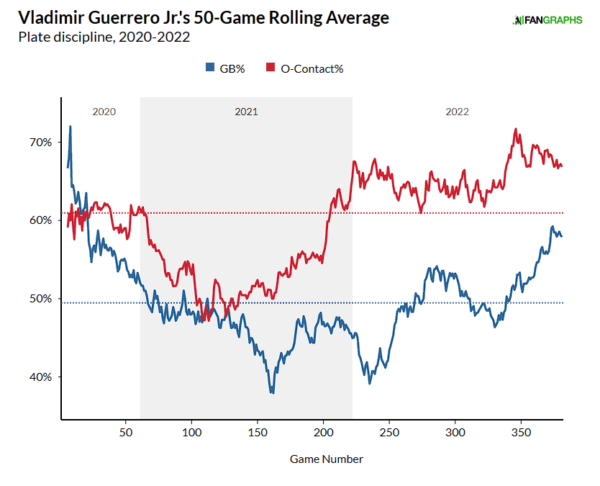
Our metrics also somewhat point to this problem, as his decision value took a nosedive in the second half of the season, and based on his corresponding swing aggression, it’s likely due to Vlad swinging at pitches he likely shouldn’t have:
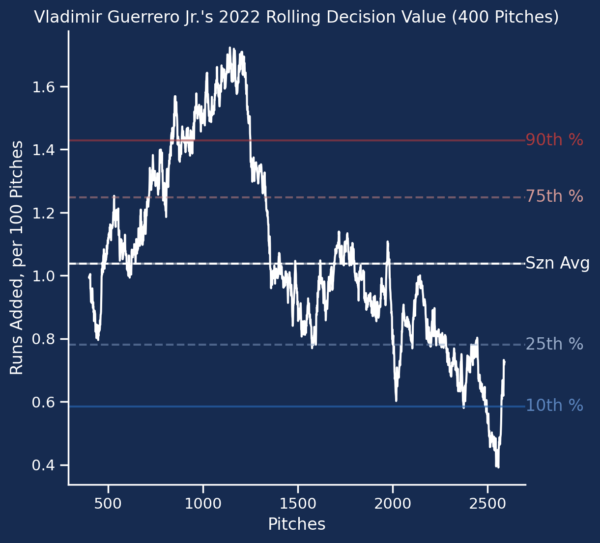
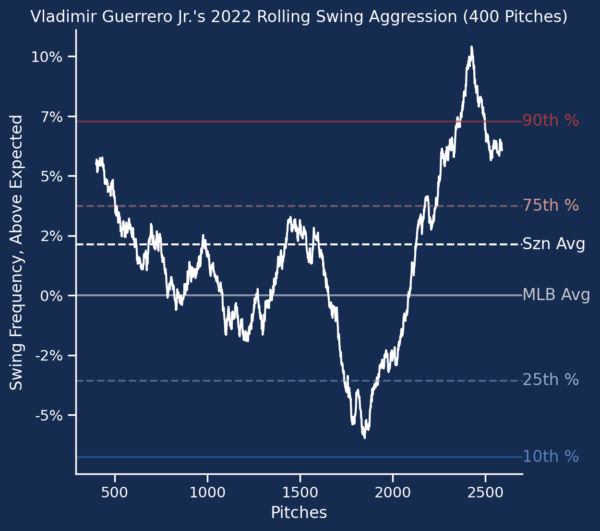
The good news is that Vlad has fixed this issue before by simply making better decisions — even when he’s more aggressive than average. By exercising just a little patience on the edges in 2023, he can return to the top of first base thanks to his chip-in speed and excellent batting average in a powerful Toronto lineup.
Tier 2
5. Ronald Acuña Jr. (ATL), OF/DH
Heading into Acuña’s age-25 season, here’s what we know: he’s really fast, he’s really strong, and he gets hurt a lot. If injuries were the only risk for Acuña for 2023, I’d feel really good about possibly reaching for him a bit in drafts, but unfortunately, there’s just a little bit more bad news that gives me the slightest bit of trepidation for Acuña going forward.
Chief among those bad news bears is the 47.7% ground-ball rate and 34% fly-ball rate. Those numbers were basically reversed in 2020 and 2021, and it’s not easy to hit home runs when you’re smashing the ball into the infield dirt half the time. That ground-ball rate helps explain why Acuña only managed 15 home runs in his 119 games after hitting 24 in just 82 games the year prior.
On the plus side, Acuña is still hitting the ball hard and is still judging the strike zone well (as you can see below), so I’m a believer that Acuña can right that launch angle ship in 2023 and get back to providing high-end production in five categories whenever he’s on the field.
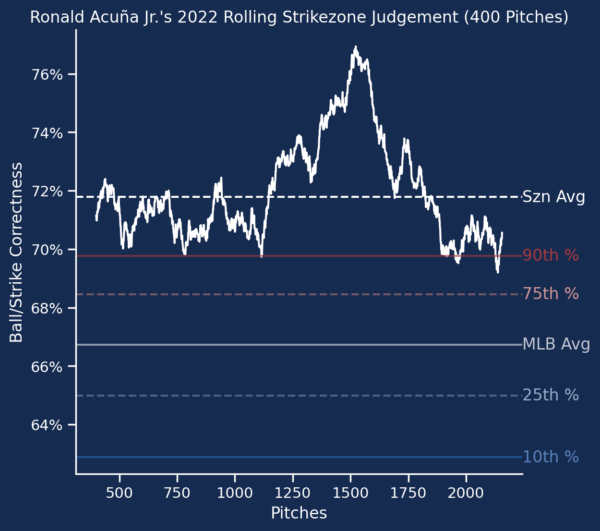
6. Manny Machado (SDP), 3B/DH
Durability and consistency are beautiful things. The last time Machado played fewer than 90% of the season was back in 2014, which is also the last time he slugged below .460. Machado has eclipsed 30 home runs in seven of the last eight full seasons, and in the shortened 2020 season he still managed to send 16 balls over the fence. Machado has also never hit below .256 in any season in the big leagues, and as a Padre, he’s batting .280/.352/.504 in 2,199 plate appearances.
Oh yeah, and Manny can steal some bases as well. He has at least five steals in each of the last six seasons, and at least nine in four of those six seasons. The rule changes surrounding steals (the limitation on pick-off attempts and the larger bases) could certainly impact a player like Manny as well, helping him reach double-digit swipes for the fourth time in his career (the most recent being in 2021).
A look at the stat lines from 2015 to the present will give you a good idea of what Manny can do. He’s a bankable 30 home runs and 100 RBI in this offense, and he’s likely to provide a plus in four of five categories while being neutral or possibly even better in steals. He doesn’t have the legs to steal 20 or more bags like J-Ram and Witt, but Machado can do just about everything else.
As a final note, for those in league formats that don’t put a premium on stolen bases (points leagues, leagues with more than 10 categories, or leagues where punting stolen bases is more effective than usual), I’d rank Machado ahead of Witt Jr at third base.
7. Shohei Ohtani (LAA), OF/DH
In daily leagues where Ohtani is eligible as both a pitcher and a hitter, I’d rank him as the top overall player without hesitation, and I think the industry as a whole is in the same boat. This ranking among DH-eligible players is meant to put a value on hitter-only Ohtani, and perhaps weekly Ohtani (who in the vast majority of situations will be in your utility or DH slot instead of pitcher).
The rolling strikeout rate chart below shows us basically the same thing as his year-to-year strikeout rate — it went down. What I like about the rolling chart, though, is that it shows me the peaks and valleys, and it’s clear in 2022 that his highest strikeout rates over 25 games were significantly lower than they were in 2022. Ohtani’s drop in strikeout rate wasn’t just some random variance or within the same range of outcomes as 2021 — his worst stretches at the plate in 2022 have a strikeout rate six or seven percentage points better than they were in 2021, and his best moments were better by about the same margin.
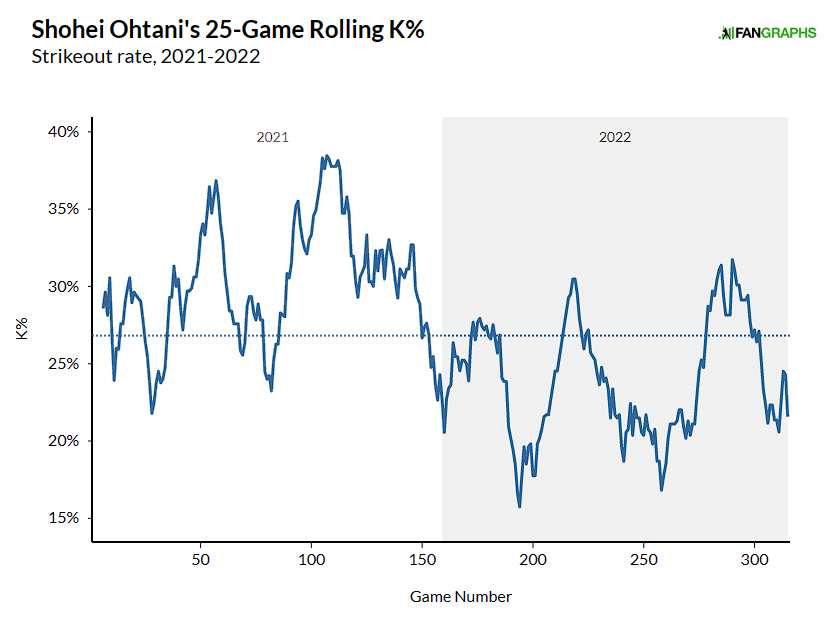
With the new lower strikeout rate seeming like it’s here to stay, I think projections putting his average close to .270 (such as THE BAT) are right on track. Whether Ohtani can get back to stealing 20 or more bases as he did in 2021 is tough to determine, because even though the rule changes should make that more feasible, the Angels have a very vested interest in limiting injuries to their best pitcher and (arguably) their best hitter wrapped into one.
I feel quite comfortable projecting the .270 batting average, .360 OBP, 35 home runs, and 180-200 combined runs and RBI. The steals should be in the double-digits, but even if they lag just a bit behind, Ohtani’s offensive upside as a just a hitter make him a first-round pick in just about every format, whether or not he can pitch for you.
8. Mike Trout (LAA), OF/DH
After the back injury news and missing most of 2021 to injuries, I thought for sure Mike Trout’s 40-home run seasons were a thing of the past, but I apparently forgot that this is Mike Trout we’re talking about here — the Millville Meteor. In just 119 games in 2022, Trout hit precisely 40 home runs with 85 runs scored and 80 RBI. Those are good numbers for a full season, much less one where the guy missed forty games.
Reports so far this offseason on Trout’s rare back disorder have been good, and Trout showed in the second half last season that he can perform at an elite level despite the condition (12 of those 40 home runs came in September). I’m not really concerned about his back condition specifically, which is saying a lot because back injuries are usually a really scary thing. Trout’s injury concerns are still a very real thing, though, and while the routine he has for his back helps him hit, I don’t think there’s a therapy out there that will get Trout back to being a base stealer.
Despite the lack of power and the injury history, I’m still all-in on a guy who has never posted a wRC+ below 160 in any season after he turned 20 (which was back in 2012). Be sure to grab a safe outfielder somewhere else early in the draft if you haven’t already, or at the very least, an extra guy with outfield eligibility in the event you need to cover for Trout for 20-30 games (or possibly more), but otherwise you don’t need to hesitate.
9. Pete Alonso (NYM), 1B/DH
The Polar Bear is coming off a 40-home run season where he drove in a whopping 131 runners while hitting .271/.352/.518 and posted his second consecutive sub-20% strikeout rate. In other words, he’s doing everything we’ve wanted the slugger to do since he exploded onto the scene in 2019 and then some.
Heading into his age-28 season, you’re not really asking Alonso to do more than what he did in 2023 — you’re just asking Alonso to do it again. While he isn’t likely to steal more than five bases, Alonso does an excellent job of putting the ball in the air and pulling it for power, and in four major league seasons, Alonso has never missed more than nine games. You can bank on something like a .260 to .270 average and another 40 home runs or so, and with the Mets’ top three hitters returning to the lineup in 2023, he’s one of the very few players who you can feel good about getting to 110 RBI. In fact, despite having 22 fewer home runs than Aaron Judge, Alonso tied him for the league lead in runners batted in.
Some might prefer Goldschmidt due to Goldy’s base-stealing ability (though he’ll need a boost from the rule changes to get to double-digits again), but in formats like head-to-head categories where stolen bases don’t carry quite as much weight, I’m more than happy to take the higher power and RBI ceilings that Alonso brings to the table.
10. Paul Goldschmidt (STL), 1B/DH
Despite being 34 years old in 2022, Goldschmidt showed little sign of slowing down. The reigning National League MVP put up the best season of his career by wRC+ and fWAR thanks to a .317/.404/.578 line, 35 home runs, seven stolen bases, and 221 combined runs and RBI batting in the heart of the St. Louis batting order.
There aren’t many questions about what Goldschmidt can do — he has at least 30 home runs in every full season since 2017, and in nine of the last ten seasons, Goldschmidt has batted at least .290. While once a stolen base threat, age has caught up to him a little in this department, stealing just seven bases in 2022 and just four combined in 2020 and 2021. The rule changes impacting pick-off moves and the size of the base might give Goldschmidt some of those stolen bases back, but it’s something that’s difficult to predict heading into the season.
If you’re in an OBP league or if you already drafted a guy like Aaron Judge in the first round for power or if you took perhaps more of a batting average risk like Bobby Witt Jr. and you’re deciding between Alonso or Goldschmidt, I have no issues going after Goldschmidt over Alonso to chase what might be a spike in stolen bases and locking in improved ratios. I prefer going for Alonso’s power, but I consider this a true toss-up.
11. Nolan Arenado (STL), 3B/DH
In his second season away from Coors, Arenado yet again delivered 30 home runs and 100 RBI — something he has done in every full season since 2016. Despite hitting .293 in 2022, Arenado doesn’t quite come with the high batting average floor of other hitters in this tier, and while he has significant pop, he’s not likely to hit 35 home runs either (you’ll have to “settle” for 30). In other words, the veteran Arenado can do all of the stuff the rest of this tier can do, he just has a little bit lower of a ceiling in most categories.
The key to Arenado’s success in the last two seasons comes largely from career-low groundball rates and career-high pull rates — in short, he’s getting the ball in the air and yanking it to the pull field, which is a classic recipe for success for power hitters, particularly those who are over the age of 30. With every reason to believe that Arenado can continue this trend, he’s a safe bet to hit 28-30 home runs and drive in 90-100 runners with a .260-.270 batting average, even if he’s not all that likely to do a whole lot more than that.
In 12-team formats, I’m doing everything in my power to get at least one of the players from these first two tiers, and in a perfect world, I might even try to get two of them. Quite frankly, none of the bats below offer the kind of floor that you see from the bats listed above. Some can hit 30 home runs and some can steal bases or hit for a high average, but almost none of them can contribute so safely to at least four categories like the bats above. The next tier can sort of come close, I guess, but after that, it starts dropping off fast.
12. Corey Seager (TEX), SS/DH
You’ve probably heard about how Seager was brutalized by the shift, batting just .245 in 2022 in large part due to losing tons of likely base hits by putting the ball right into a shifted infielder’s glove. It’s true, few players were shifted as often as Seager and it was quite effective in limiting hits, taking 80 points off his batting average on groundballs and roughly 100 points from his batting average on grounders and line drives. Seager is a perfect example of a hitter who is likely to benefit from the new rules that prevent overloading one side of the infield, and while teams will still likely use defensive positioning to take hits away, the new rules combined with just some good ol’ fashioned regression to the mean should help Seager be something more like his career .287 batting average.
That said, I wouldn’t necessarily expect Seager to go back to being a .300 hitter, as part of the reason the shift was so successful is that Seager has intentionally started pulling the ball over the last three seasons. While he doesn’t pull a lot of fly balls (a trait that can help significantly increase home runs), Seager did pull the most fly balls of his career in 2022 thanks to a combination of a career-high pull rate and close to a career-high fly ball rate. That combination accounted for 15 home runs and three doubles in 2022 on 37 pulled fly balls and considering Seager has a 2.512 OPS on pulled fly balls in his career, I’d say I’m more than happy to see a modest reduction in batting average (to something like, say, .270 or .275) if it means he keeps yeeting pitches over the wall in right field.
If Seager can come close to 30 home runs again while regaining 30 or 40 points of his lost batting average (a high number, but also a reasonable one considering his skill set), Seager could wind up in the top tier of shortstops in 2023 — a remarkable feat for a guy who has never stolen five bases in a season.
13. Kyle Schwarber (PHI), OF/DH
Schwarber gonna Schwarbs, you know? By Schwarbs, I mean walk a ton, strike out a ton, and mash a ton of dingers. Schwarber is truly a three-outcomes type of hitter, though in his defense, he’s really good at making the two positive outcomes and doing so enough to offset how often he strikes out.
The .218 batting average was pretty brutal in 2022, and that batting average can be partially explained by some bad batted ball luck (his BABIP was 28 points lower than his career mark) and a high fly-ball rate (51.1%). Still, Schwarber hits the ball so dang hard and barrels it so consistently that I feel he should really be closer to a .230 or .240 hitter than a .220 hitter.
Fun fact — Schwarber led off 123 times for the Phillies in 2022, and his career batting average as a leadoff hitter is .224. The addition of Trea Turner to this lineup should mean that Schwarber will no longer need to serve that role. Schwarber’s career average in 861 plate appearances batting second, third, or fourth? A smooth .245.
14. Adolis García (TEX), OF/DH
Over the last two seasons combined, García has 58 home runs and 47 stolen bases — an elite combination that’s only held back by somewhat limited on-base skills. To his credit, García brought the strikeout rate below 30% and down to 27.9% in 2022 and also added a point to his walk rate, helping him get to a neat and tidy .250 batting average and .300 OBP.
Long term, García’s skill set is likely the type to erode with age, and it will likely erode fast — García will turn 30 before the season begins and it’s just a matter of time before the strikeout rate and stolen bases disintegrate if he doesn’t change his approach. That said, these are redraft rankings, and I’m not worried about how many years García can keep up this aggressive approach — I just care about whether he can do it again for one more year.
Based on the excellent power numbers and upward-trending contact numbers from our lovely PLV stats from last season, I think the answer is yes—García can do this for one more year:

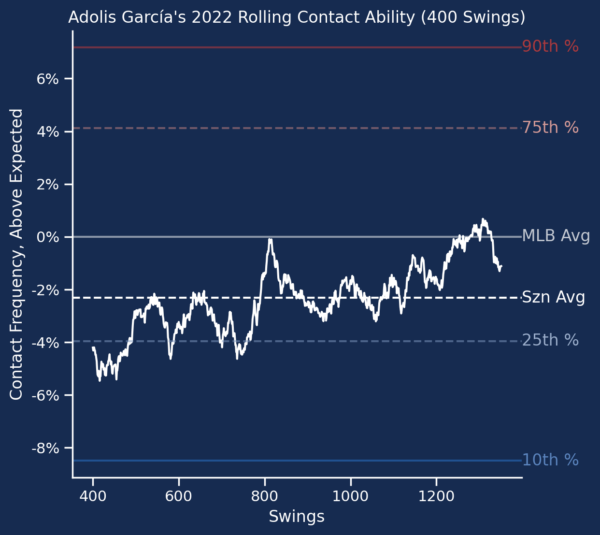
15. Randy Arozarena (TBR), OF/DH
Thanks to rule changes and team context, Arozarena should be good for another 20 home runs and 25-30 stolen bases in 2023, and I was really happy to see his strikeout rate drop a solid four points from 2021. Strikeouts were the scariest part of Arozarena’s game in years past, and while I don’t expect Arozarena to be a guy who strikes out less than league average, he can still provide a neutral-to-good batting average with average plate discipline thanks to his power and speed.
Icon Sportswire | Adapted by Doug Carlin and Aaron Polcare (@Bdougals and @bearydoesgfx on Twitter)
